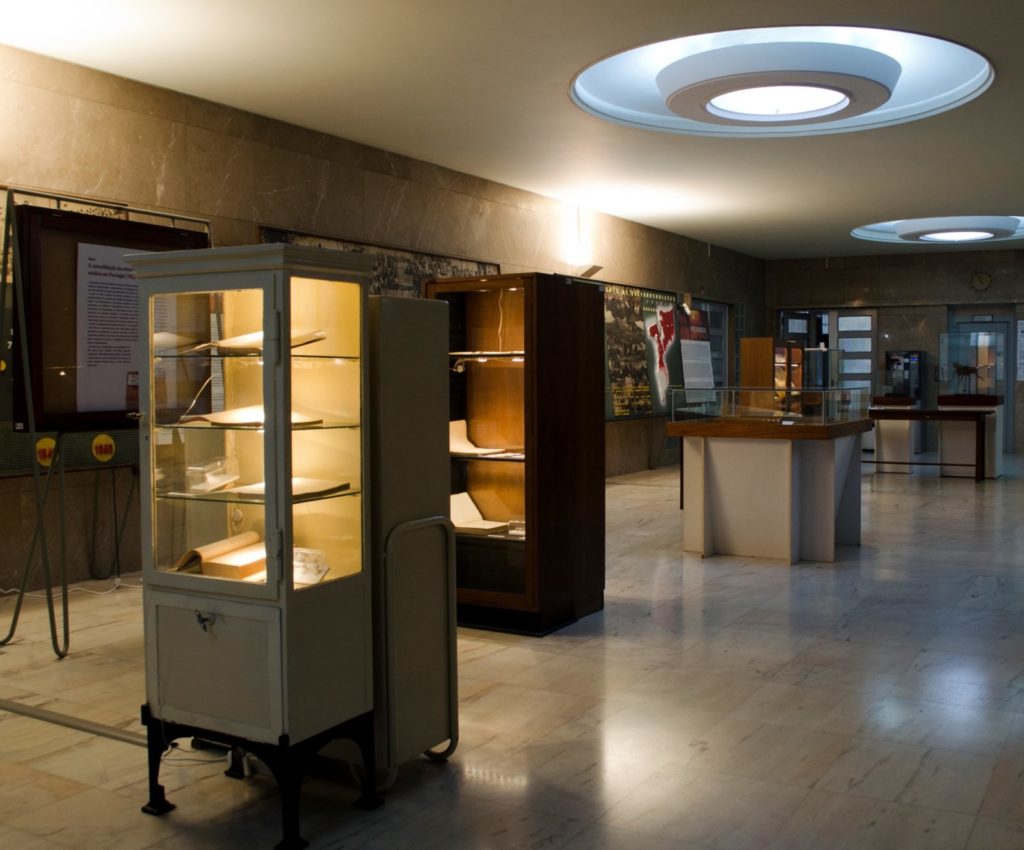Esta exposição tem coordenação da investigadora CIUHCT Ana Rita Lobo, e será apresentada ao público pelas 11h30 de dia 12 de Dezembro, no Instituto de Higiene e Medicina Tropical, no âmbito das suas 9ªs Jornadas Científicas. O programa do evento decorrerá ao longo do dia, na sala Fraga de Azevedo. Posteriormente, poderão ser marcadas visitas guiadas, contactando directamente a investigadora.
DESCRIÇÃO
Esta mostra pretende olhar para a ENTOMOTECA Henrique Ribeiro e Helena Ramos e refletir sobre a íntima relação entre a entomologia médica e a medicina tropical portuguesa, entre 1902 e 1966. Durante este período, a Escola de Medicina Tropical de Lisboa e o Instituto de Medicina Tropical contribuíram para uma história mais abrangente da entomologia médica no século XX, através dos seus investigadores, da rede de conhecimentos que estabeleceram, e da produção científica e didática que deixaram como legado. Este legado pode ser hoje visualizado através de vários objectos documentais e materiais que entre si dialogam e que permitem estabelecer a narrativa desta mostra museológica.
A importância médica de alguns insectos surgiu no final do século XIX com a aceitação do seu envolvimento no ciclo de vida de parasitas responsáveis por grande número de doenças tropicais. O estudo do papel dos artrópodes na transmissão de doenças parasitárias por parte da comunidade médica e o envolvimento da comunidade de zoólogos na sua identificação, classificação taxonómica e na caracterização da sua bio-ecologia, determinou o desenvolvimento de uma nova área de conhecimento conhecimento especializado, em 1910, a entomologia médica, permitindo assim a compreensão e o desenvolvimento de estratégias de combate àquelas doenças (Coluzzi et al, 2008).
A escola portuguesa de medicina tropical, por analogia com as suas congéneres britânicas, estabeleceu um programa de investigação no qual a entomologia médica ocupava um papel de relevo. Neste contexto destaca-se a investigação realizada na metrópole e as missões de estudo enviadas a África e à Índia para o estudo de várias patologias. Como resultado destas missões e do intercâmbio científico realizado, vários insectos de diferentes grupos taxonómicos foram sendo coleccionados pelos seus investigadores. Este acervo entomológico histórico foi reorganizado por Henrique Ribeiro (1930-2005) e por Helena Ramos (n. 1936) a partir de 1970, e existe actualmente na ENTOMOTECA do Instituto de Higiene e Medicina Tropical de Lisboa.
Esta mostra museológica organiza-se em dois núcleos expositivos, organizados em três secções cada um, que circunscrevem os períodos de existência das duas instituições, a Escola de Medicina Tropical de Lisboa (EMT) entre 1902 e 1935 e o Instituto de Medicina Tropical de Lisboa (IMT) entre 1935 e 1966, com enfoque no ensino, na investigação e na criação de redes de conhecimentos e práticas, nos quais a entomologia médica portuguesa se insere.
O trabalho foi realizado com o financiamento da Fundação para a Ciência e a Tecnologia (SFRH/BPD/110936/2015).
Comissariado por: Ana Rita Lobo e Isabel Amaral (com Maria Teresa Novo, Luís Filipe Lopes e António Paulo Gouveia de Almeida).
This exhibition is coordinated by the CIUHCT researcher Ana Rita Lobo, and will be presented to the public at 11h30 of December 12th, at the Institute of Hygiene and Tropical Medicine, in the scope of its 9th Scientific Journeys. The program of the event will take place throughout the day, in the Fraga de Azevedo room. Afterwards, guided tours can be arranged by contacting the researcher directly.
DESCRIPTION
This exhibition aims to look at ENTOMOTECA Henrique Ribeiro and Helena Ramos and reflect on the intimate relationship between medical entomology and Portuguese tropical medicine between 1902 and 1966. During this period, the Lisbon School of Tropical Medicine and the Institute of Tropical Medicine contributed to a more comprehensive history of medical entomology in the 20th century, through their researchers, the network of knowledge they established, and the scientific and didactic production they left as a legacy. This legacy can be visualized today through various documentary objects and materials that dialogue with each other and that allow the narrative of this museological exhibition to be established.
The medical importance of some insects emerged at the end of the 19th century with the acceptance of their involvement in the life cycle of parasites responsible for a large number of tropical diseases. The study of the role of arthropods in the transmission of parasitic diseases by the medical community and the involvement of the zoological community in their identification, taxonomic classification and characterization of their bio-ecology, determined the development of a new area of expertise, in 1910, medical entomology, thus allowing the understanding and development of strategies to combat those diseases (Coluzzi et al, 2008).
The Portuguese School of Tropical Medicine, by analogy with its British counterparts, established a research programme in which medical entomology played an important role. In this context, the research carried out in the metropolis and the study missions sent to Africa and India to study various pathologies stand out. As a result of these missions and the scientific exchange carried out, several insects from different taxonomic groups were collected by their researchers. This historical entomological collection was reorganized by Henrique Ribeiro (1930-2005) and Helena Ramos (b. 1936) from 1970 onwards, and currently exists at ENTOMOTECA of the Institute of Hygiene and Tropical Medicine of Lisbon.
This museum exhibition is organized in two exhibition groups, each divided in three sections, which circumscribe the periods of existence of the two institutions, the Lisbon School of Tropical Medicine (EMT) between 1902 and 1935 and the Lisbon Institute of Tropical Medicine (IMT) between 1935 and 1966, with a focus on teaching, research and the creation of networks of knowledge and practices, in which Portuguese medical entomology is included.
The work was carried out with funding from the Foundation for Science and Technology (SFRH/BPD/110936/2015).

